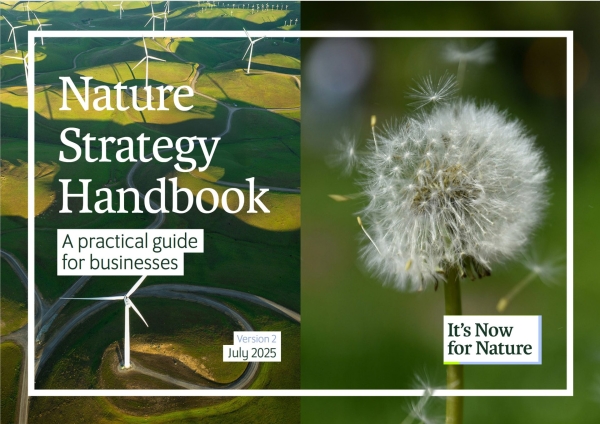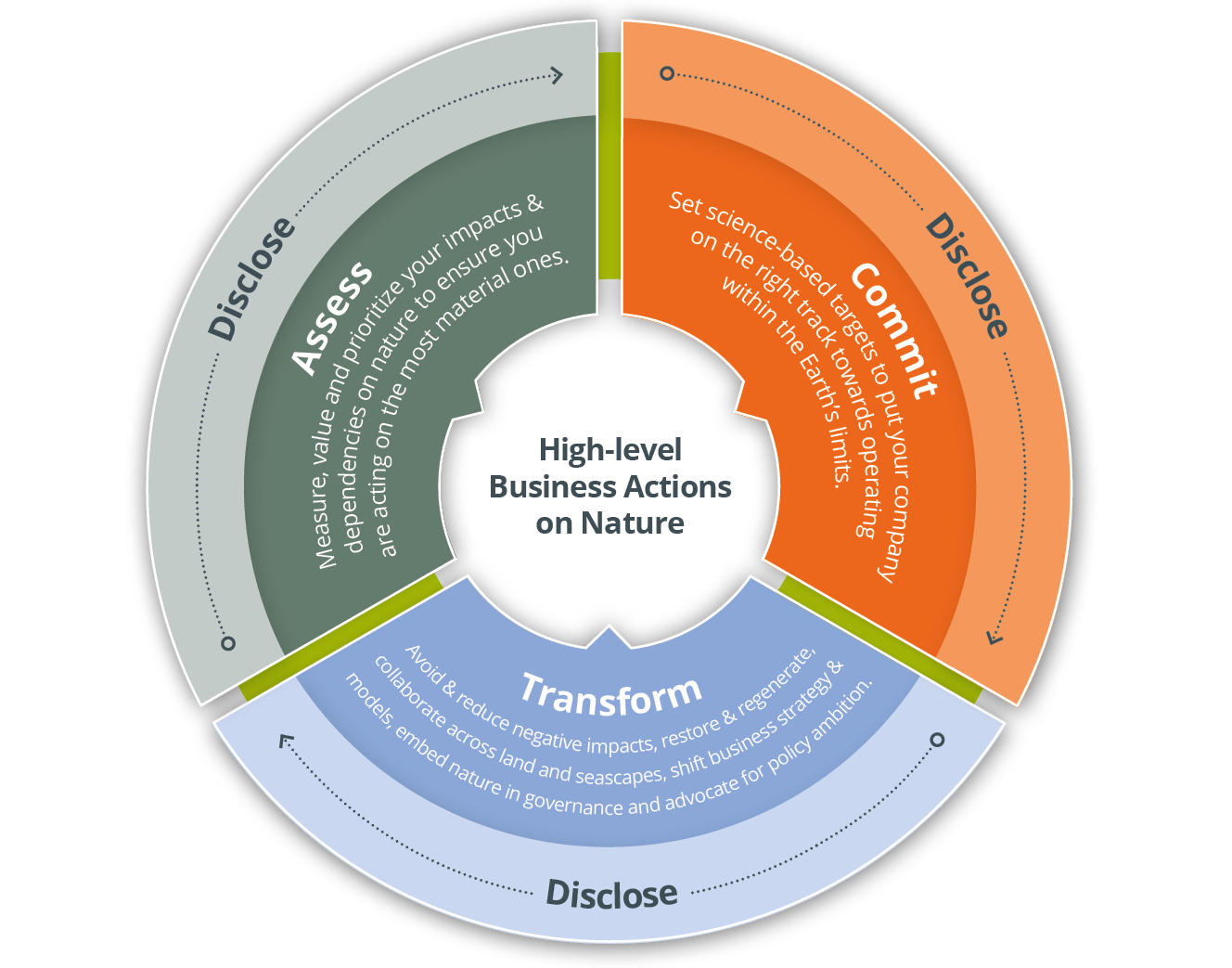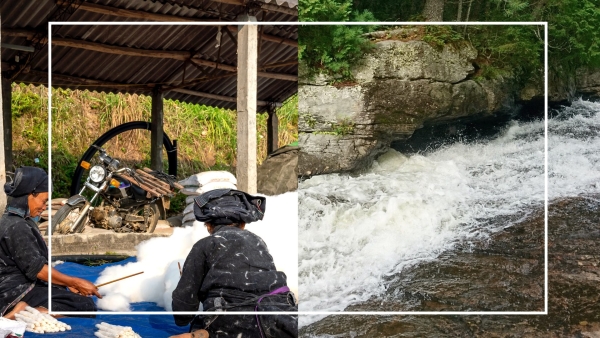
The Nature Strategy Handbook is a practical guide to support all businesses in developing a nature strategy. The Handbook builds on guidance from the ACT-D High-Level Business Actions on Nature to show the key components of a credible nature strategy, taking into account the requirements of various frameworks, guidance and regulations.
It provides a set of guiding questions, recommendations and resources for how to develop a strategy for nature – whether that is as a stand-alone document or included in your business, climate or sustainability strategy.
Using the handbook to set a credible nature strategy can help your business reduce its negative impacts on nature, boost its resilience to nature risks, access new commercial opportunities, create long-term value and strengthen your climate and sustainability goals. This in turn will help your organization make a meaningful contribution towards the global goal to halt and reverse nature loss by 2030.
Jul 2025
Nature Strategy Handbook
A practical guide for businesses
pdf, 3 MB
Read the HandbookNov 2023
自然战 略手册
企业实用指南
pdf, 5 MB
阅读手册Nov 2023
Manual de Estrategias para la Naturaleza
Una guía práctica para las empresas
pdf, 799 KB
Leer el manualNov 2023
Manuel de stratégie pour la nature
Un guide pratique pour les entreprises
pdf, 801 KB
Lire le manuelNov 2023
自然再興戦略ハンドブック
企業のための実践的なガイド
pdf, 3 MB
ハンドブックを読むNov 2023
Manual de Estratégia para a Natureza
Um guia prático para as empresas
pdf, 798 KB
Ler o manualHow was the Nature Strategy Handbook developed?
The Handbook was developed in partnership with the Business for Nature coalition organizations with PwC UK as the knowledge partner of the campaign. It builds on the best available resources to help businesses align with the level of ambition required to halt and reverse nature loss.
Throughout its development, the content was reviewed by an extensive list of partner organizations and businesses.
About this Handbook
This Handbook forms the basis of ‘It’s Now for Nature,’ a global campaign aimed at rallying all businesses to act on nature and contribute towards the mission of the Global Biodiversity Framework to halt and reverse nature loss by 2030. Businesses are encouraged to develop and submit their strategy on the It’s Now for Nature website to become part of the campaign and join the growing number of companies that recognize they need to scale and speed up business action on nature. Nature should ideally be embedded as a core part of an organization’s strategy; however, many companies are not yet there and need encouragement to get started. It’s Now for Nature accepts a broad scope of nature strategies that strongly demonstrate that a company is strategically considering nature, including:
- Core business strategies that embed nature
- Integrated nature, climate and/or sustainability strategies
- Stand-alone nature strategies
- TNFD reports
- Nature transition plans
This Handbook:
- Aims to support all businesses to develop a nature strategy: The purpose of the Nature Strategy Handbook is to support all businesses to develop and publish a nature strategy, which will help them unlock the true value of nature and enable them to make a meaningful contribution towards a nature-positive world.
- Acts as an entry point to nature-related frameworks and regulations: The Nature Strategy Handbook functions as an entry point, signposting businesses to the various nature-related frameworks and reference materials at each stage of developing a nature strategy. The Handbook has been developed to align with the requirements of current nature-related frameworks and regulations such as the Corporate Sustainability Reporting Directive (CSRD), the Taskforce on Nature-related Financial Disclosures (TNFD), and the Science-based Targets Network (SBTN). It also draws on WBCSD’s Roadmaps to Nature Positive: Foundations for all businesses and Nature Action 100 (NA100). By building on these resources and requirements, the Nature Strategy Handbook provides a common direction for all businesses to begin or continue their journey towards a nature-positive future by setting a strategy for nature.
- Is structured around the high-level business actions (ACT-D): The layout of the Nature Strategy Handbook builds on the ACT-D High Level Business Actions on Nature (Assess, Commit, Transform and Disclose) to illustrate the key components of a credible nature strategy for businesses. It delves into each stage in depth, providing a set of guiding questions, recommendations, and resources for developing a strategy for nature, whether that is as a stand-alone document or included in a business, climate, or sustainability strategy.
How to use the Nature Strategy Handbook
The Nature Strategy Handbook is a guide for businesses to develop effective, forward-looking nature strategies by providing clear recommendations for assessing nature-related dependencies, impacts, risks, and opportunities, navigating established frameworks, and identifying useful tools and resources. The Handbook follows the four high-level business actions outlined in ACT-D: Assess, Commit, Transform and Disclose and guides readers to include these actions within their nature strategy by breaking down each into four parts:
1) Steps: The Nature Strategy Handbook is structured into the four high-level actions of ACT-D (Assess, Commit, Transform and Disclose). Each of these high-level actions is then broken down into key steps that summarize the content of a nature strategy.
2) Guiding questions: Within each step there are guiding questions to help businesses identify the information required to develop their nature strategy. These are useful starting points for businesses that want to develop their first strategy and could be used as discussion questions in an internal strategy workshop.
3) Recommendations: The recommendations provide clarity on the content that should be included within a credible nature strategy in response to the guiding questions.
4) Supporting resources: The external resources provide references and links to widely used nature-related frameworks and approaches. Businesses should use these resources to support their development of a nature strategy in line with the recommendations. (These resources were all last accessed in July 2025.)
While following a broadly logical order, the Handbook is not a design template for a nature strategy. This leaves businesses responsible for controlling the order and flow of content within their strategy. Developing a nature strategy is an iterative process, and organizations will have to go through different cycles of ACT-D to strengthen their strategy during each cycle.
The featured strategies on the It’s Now for Nature website can be used as examples and a source of inspiration.
A glossary is included at the end of the Handbook, providing definitions for all key terms referenced.

What is ACT-D?
ACT-D refers to the High-level Business Actions on Nature: Assess, Commit, Transform and Disclose developed in a collaboration by the Capitals Coalition, Business for Nature, WBCSD, TNFD, the Science Based Targets Network, the World Economic Forum and WWF and supported by many key organizations.
The content in this Handbook builds on ACT-D to show businesses how to set a forward-looking nature strategy and where to find the most useful tools and expertise.
ACT-D guides businesses through the various tools, frameworks and initiatives to support businesses in assessing their relationship with nature, setting targets, and taking actions to avoid and reduce negative impacts while restoring and regenerating nature.

How to include 'Assess' in your nature strategy
Articulate the material impacts and dependencies on nature associated with your business model. Outline your material risks and opportunities, covering how these will affect your business model, strategy and financial planning. Explain how your nature strategy is integrated with your business model, and wider corporate strategies (including climate and people).
Step 1: Conduct an initial materiality assessment to prioritize efforts
Guiding questions:
- How did you perform your initial materiality assessment to identify potential dependencies and impacts on nature, and what threshold did you use?
- What are your prioritized impacts and dependencies and where in your value chain do these occur?
- When do you expect these material impacts and dependencies to arise (short, mid, or long-term)?
Recommendations (your strategy should include):
- The scope of your materiality assessment, including:
- Activities
- High-impact commodities
- Value chain (upstream, downstream and direct)
- o Geographical location and specificity
- Your plans to increase the scope of your nature assessment over time
- An overview of your material impacts and dependencies
- The stage(s) in your value chain your material impacts and dependencies are located
Resources:
- ENCORE Explore Tool
- SBTN Step 1 Technical Guidance [Step 1A: Materiality Assessment (p. 30)]
- Natural Capital Protocol Scope Stage
- TNFD: Guidance on the identification and assessment of nature-related issues: the LEAP approach [Locate: L1 (p. 43), L2 (p. 46)]
- WBCSD Roadmaps to Nature Positive – Foundations for all Businesses [Assess (p. 9)]
- Business for Nature, WBCSD, and World Economic Forum Sector Actions Towards a Nature-Positive Future
- Asking Better Questions on Nature – For board Directors
Step 2: Measure and evaluate impacts and dependencies on nature
Guiding questions:
- How do the locations of your direct operations and value chain interface with sensitive areas for nature?
- In which geographic locations do your material impacts and dependencies occur?
- What methodologies are you using to measure and evaluate your material impacts and dependencies on nature, and over what time period?
- What metrics are you using to measure and evaluate your material impacts and dependencies?
- What magnitude are your material impacts and dependencies?
Recommendations (your strategy should include):
- An overview of the locations where your material impacts and dependencies occur
- An overview of how your locations interface with sensitive areas for natureAn evaluation of your material impacts and dependencies, including the methodologies and metrics used, and any interconnections
- An evaluation of your material impacts and dependencies, including the methodologies and metrics used, and any interconnections
Resources:
- Natural Capital Protocol [Measure and Value Stage]
- Capitals Coalition Integrated Decision Making Framework
- SBTN Step 1 Technical Guidance [Step 1B: Value Chain Assessment, (p. 54)]
- SBTN Step 2 Technical Guidance [Step 2B: Interpret and Rank, (p. 34)]
- TNFD: Guidance on the identification and assessment of nature-related issues: the LEAP approach [Locate: L3 (p. 50); Evaluate: E1 (p. 69), E2 (p. 71), E3 (p. 78)]
- TNFD Guidance on Scenario Analysis
- WBCSD Roadmaps to Nature Positive – Foundations for all Businesses [Assess (p. 10)]
- Business for Nature, WBCSD, and World Economic Forum Sector Actions Towards a Nature-Positive Future
Step 3: Assess risks and opportunities
Guiding questions:
- What are your nature-related risks and opportunities based on your assessment of your dependencies and impacts and where in your value chain do these occur?
- When do you expect your nature-related risks and opportunities to arise (short, mid, or long-term)?
- Which locations do your nature-related risks and opportunities relate to, and do these overlap with ecologically sensitive areas?
- What methodologies are you using to prioritize and assess your nature-related risks and opportunities, and over what time period?
- What metrics are you using to monitor and assess your risks and opportunities?
- How do your risks and opportunities affect your business model, value chain, strategy, financial planning, and transition plans?
- What are the current or potential financial impacts of your nature-related risks and opportunities?
Recommendations (your strategy should include):
- Your material nature-related risks and opportunities (based on your impacts and dependencies)
- Where your material nature-related risks and opportunities exist in your value chain, including any key geographical locations and sensitive areas affected
- How your material risks and opportunities affect your business model, strategy, financial planning, and transition plans
- The methodologies and metrics you are using to assess and manage these material risks and opportunities
Resources:
- TNFD: Guidance on the identification and assessment of nature-related issues: the LEAP approach [Assess: A1 (p. 101), A2 (p. 113), A3 (p. 117)]
- TNFD Sector Guidance
- WWF Risk Filter Suite
- WBCSD Roadmaps to Nature Positive – Foundations for all Businesses [Assess (p. 13)]
- CISL NBS Diagnostic tool
- SBTN Step 2 Technical Guidance [Step 2C: Prioritization, (p.46)]
Step 4: Consider climate and people within your nature assessment
Guiding questions:
- How have you considered climate (including the impact of climate change as a driver of nature loss; nature-based solutions as mitigation and adaptation to climate) within your assessment?
- Have you assessed potential impacts on Indigenous Peoples and Local Communities within your direct operations and value chain?Which locations do your material nature-related risks and opportunities relate to?
Recommendations (your strategy should include):
- A description of how you consulted internal and external stakeholders in the assessment of your material nature-related impacts, dependencies, risks, and opportunities (this includes the key issues and interests identified by these stakeholders, and the actions taken in response during the assessment)
- A description of your stakeholders, which should represent your entire value chain and include any which are relevant out of those listed below:
- Your workforce
- Communities living adjacent to your business operations or sourcing activities
- Communities living at a distance but affected by your environmental impacts
- Customers
- Sources/suppliers
- Experts and NGOs
- Women and girls
- Indigenous Peoples
- Others as relevant
- A description how you considered climate in your assessment of material risks and opportunities, including options for utilizing Nature-based Solutions for mitigation and adaptation efforts
Resources:

How to include ‘Commit’ in your nature strategy
Provide an overview of the ambition you have as a business to contribute towards a nature-positive world. Include a summary of the targets you have set for nature, their time horizons and key milestones, what impacts, dependencies, risks and opportunities they relate to, and your plan for monitoring progress.
Step 1: Define ambition and goals
Guiding questions:
- What is your ambition for your nature strategy and what effect do you want this strategy to have on nature and your business?
- Does this ambition align with a nature-positive future (and with the goals and targets of the Global Biodiversity Framework)?
- What is your timeline to achieve this ambition?
- What is your business case for taking action on nature?
Recommendations (your strategy should include):
- Your nature ambition statement, including your business case for taking action
- A description of how your nature ambition contributes to a nature-positive world by 2030 and aligns with Global Biodiversity Framework goals and targets
Resources:
Step 2: Set targets
Guiding questions:
- What targets have you set to contribute to achieving your ambition, and which parts of your business and value chain do these relate to?
- What impacts, dependencies, risks or opportunities do your targets relate to?
- How do you plan to monitor, evaluate and disclose progress towards your targets?
- Have you considered whether any other targets (e.g., climate, social or other sustainability targets) relate to your nature targets?
Recommendations (your strategy should include):
- The nature-related targets (SMART) you have set, including:
- How they relate to your nature ambition
- The geographical location (if relevant), and parts of your business and value chain they relate to
- The impacts, dependencies, risks and opportunities (identified under Assess) they relate to
- The timeframe to achieve the targets, including any milestones or interim targets
- Whether they are validated by third-party stakeholders and/or if they are science-based, science-aligned or not at all
- Your plan to monitor, evaluate and disclose progress against your targets, including the metrics, KPIs, baseline value, and base year (if applicable) used for each target and your plans to fill any information gaps
- How your nature and climate targets support each other
Resources:
- TNFD: Guidance on the identification and assessment of nature-related issues: The LEAP approach [Prepare: P1 (p.138)
- TNFD: Guidance on the identification and assessment of nature-related issues: the LEAP approach [Prepare: P2 (p.143)]
- TNFD Discussion Paper on Nature Transition Plans
- TNFD Guidance on Target Setting
- SBTN Step 3: Measure, Set & Disclose Targets
- WBCSD Roadmaps to Nature Positive – Foundations for all Businesses [Commit and Transform (p.26)]
- SBTN: Corporate Manual for Setting Science-based Targets for Nature

How to include ‘Transform’ in your nature strategy
Describe the actions you will undertake to address your relationship with nature, to deliver on your targets and achieve your ambition. Explain which stakeholders you have engaged with in forming your strategy, and your plans for future engagement. Outline your governance structure and the practical mechanisms which will ensure that the strategy is implemented across your business.
Step 1: Avoid and reduce
Guiding questions:
- What actions are you taking to avoid negative impacts on nature?
- What actions are you taking to reduce negative impacts on nature?
- How do these actions relate to and manage your material impacts, dependencies, risks and opportunities?
- How are you monitoring and evaluating the progress of these actions, and how do these relate to your ambition targets?
- Are there material impacts you are not able to avoid and reduce and why?
Recommendations (your strategy should include):
- The actions you are taking to avoid and reduce your impacts on nature based on your materiality assessments, explaining:
- The activities and locations covered
- How these actions manage identified impacts, dependencies, risks, and opportunities
- How these actions relate to your business and value chain
- How these actions relate to your ambition and targets
- How these actions are prioritized
- How these actions will be monitored and evaluated to ensure progress, including the metrics used
Resources:
- SBTN Initial Guidance for Business [Act (p. 41)]
- Sector Actions towards a Nature-Positive future
- TNFD: Guidance on the identification and assessment of nature-related issues: the LEAP approach [Prepare: P1(p.139)]
- TNFD Discussion paper on nature transition plans
- TNFD Sector Guidance
Step 2: Restore and regenerate
Guiding questions:
- What actions are you taking to restore and regenerate nature?
- How do these actions relate to your impacts, dependencies, risks and opportunities?
- How are you monitoring and evaluating the progress of these actions, and how do these relate to your ambition targets?
Recommendations (your strategy should include):
- The actions you are taking to restore and regenerate nature based on your materiality assessments, explaining:
- The activities and locations covered
- How these actions manage your identified impacts, dependencies, risks, and opportunities
- How these actions relate to your business and value chain
- How these actions relate to your ambition and targets
- How these actions are prioritized
- How these actions will be monitored and evaluated to ensure progress, including the metrics used
Resources:
- SBTN Initial Guidance for Business [Act (p. 41)]
- Sector Actions towards a Nature-Positive future
- TNFD Discussion paper on nature transition plans
- TNFD Sector Guidance
Step 3: Shift business strategy and models
Guiding questions:
- What actions are you taking to manage your identified nature-related risks and opportunities?
- What are the options and trade-offs related to your actions on nature-related risks and opportunities?
- How are you adapting your business strategy and models to contribute to a nature-positive world?
- What resources and financial / organizational changes are required to achieve the transformation?
- How does your nature strategy integrate with and support your climate, social and wider corporate strategies?
Recommendations (your strategy should include):
- The actions you are taking to manage your material nature-related risks and opportunities
- The resilience of your business strategy and models to nature-related impacts, dependencies, risks and opportunities
- The changes you are making to your business strategy and models as part of your actions to manage impacts, dependencies, risks and opportunities
- The resources or financial / organizational changes required for this transformation, including nature-related capacity building
- How your nature strategy integrates and supports your climate, social and wider corporate strategies
- Details on whether you have, or plan to have, a nature transition plan
Resources:
- Guidance on the identification and assessment of nature-related issues: the LEAP approach [Prepare: P1 (p. 139)]
- TNFD Discussion paper on nature transition plans
- TNFD Sector Guidance
- Bridging Business and Nature: New WWF report supports companies in crafting Nature Transition Plans. | WWF
Step 4: Collaborate, both along your value chain, and at a landscape, seascape and river basin-level
Guiding questions:
- How are you engaging and collaborating with your value chain on nature?
- How are you collaborating with stakeholders to deliver improved nature outcomes at a landscape, seascape, and river basin level?
- How have you considered the perspectives of other stakeholders in the design of this strategy?
- How is your business supporting other businesses to advance action on nature?
Recommendations (your strategy should include):
- How you are engaging and collaborating with your value chain and other stakeholders to:
- Avoid and reduce
- Regenerate and restore
- Achieve your targets and ambition
- The internal and external stakeholders consulted in the design of the strategy (in response to nature-related impacts, dependencies, risks and opportunities), the key issues and interests identified by these specific stakeholders, and the actions taken in response to stakeholder concerns and interests – these stakeholders should represent your entire value chain and include any which are relevant, out of all those listed below:
- Your workforce
- Communities living adjacent to your business operations or sourcing activities
- Communities living at a distance but affected by your environmental impacts
- Customers
- Experts and NGO’s
- Indigenous Peoples
- Women and girls
- Sources/suppliers
- Others as relevant
- How stakeholders affected by your nature-related activities are formally engaged
Resources:
- SBTN Stakeholder Engagement Guidance
- TNFD: Guidance on engagement with Indigenous Peoples, Local Communities and affected stakeholders
- FPIC Protocol Guide — SIRGE Coalition
- UN Global Compact Guide to Traceability
- IUCN’s Global Standard for Nature-based Solutions
- WBCSD Roadmaps to Nature Positive – Foundations for all Businesses [Commit and Transform (p. 27)]
- TNFD guidance on Transition Plans
Step 5: Advocate for ambitious policies and initiatives
Guiding questions:
- How are your advocacy activities aligned with the ambition of the Global Biodiversity Framework’s goals and targets?
- How are your trade associations’ positions aligned with your nature ambition, and supporting the ambition of the Global Biodiversity Framework’s goals and targets?
Recommendations (your strategy should include):
- An outline of the nature-related advocacy activities and policy engagements you are involved in
- How your advocacy activities and policy engagements align with your ambition and with the ambition of the Global Biodiversity Framework’s goals and targets and reasons for any misalignment
- An overview of the key trade associations you are a member of and how they align with your ambition
Resources:
- Business for Nature’s Policy Recommendations
- Business for Nature – Responsible Policy Engagement Guide
- Metabolic Nature-based Solutions Policy Tracker
- We Mean Business Coalition: A Framework for Responsible Policy Engagement
- WBCSD Roadmaps to Nature Positive – Foundations for all Businesses [Commit and Transform (p.28)]
- TNFD guidance on Transition Plans
Step 6: Embed nature within your corporate governance
Guiding questions:
- What governance and management bodies have oversight and responsibility for this strategy?
- What reporting structures are in place to inform governance bodies and wider stakeholders regarding progress on the strategy?
- How is nature integrated within your overall risk management process and what additional policies, frameworks, procedures and resources are in place to deliver this strategy?
- What stakeholder engagement and grievance processes do you have in place and who is responsible for them?
Recommendations (your strategy should include):
- The board and/or executive management-level committee that has oversight of this strategy
- Your processes for managing and monitoring the actions taken in light of this strategy
- The roles and responsibilities of the administrative, management and supervisory bodies in exercising oversight and being informed of the process to manage material impacts, dependencies, risks and opportunities, including management’s role in these processes
- Whether nature-related performance is integrated into incentive schemes
- The process for identifying, assessing, prioritizing and managing nature-related risks and how this is integrated into your overall risk management process
- Any additional policies, frameworks, procedures (including human rights policies and grievance mechanisms) and resources in place to deliver, and communicate this strategy, including stakeholder engagement and nature-related capacity building
Resources:
- TNFD: Recommendations of the Taskforce on Nature-related Financial Disclosures v1.0
- WBCSD Roadmaps to Nature Positive – Foundations for all Businesses [Commit and Transform (p. 27)]
- TNFD guidance on Transition Plans
- TNFD, Chapter Zero, Competent Boards, Commonwealth Climate and Law Initiative and Green Finance Institute Asking Better Questions on Nature – For board Directors

How to include ‘Disclose’ in your nature strategy
Outline the steps you are taking to ensure your strategy is credible. Explain how you will align with major reporting standards to communicate delivery against your strategy.
Step 1: Seek out independent validation and verification to enhance credibility of actions
Guiding questions:
- How have you sought/will you seek internal assurance and independent external assurance on your nature strategy and disclosures?
- Are there any additional nature initiatives, certifications or accreditations which you align to or meet the requirements for?
- How are you engaging with independent validating bodies on your nature targets?
Recommendations (your strategy should include):
- A description of the parts of your nature strategy and disclosures that you have sought/will seek internal assurance and independent external assurance over, and who provided this assurance
- Details on whether you have or plan to have, a nature transition plan to support strategy delivery
- Details of whether you are currently engaging or plan to engage with any independent bodies to validate your nature target(s)
- Any nature initiatives, certifications or accreditations that you align to, or meet the requirements for that have not been covered under other elements of the strategy (e.g., regional or national certifications/initiatives
Resources:
- TNFD: Recommendations of the Taskforce on Nature-related Financial Disclosures v1.0
- SBTN Guide for Readers
- TNFD, Chapter Zero, Competent Boards, Commonwealth Climate and Law Initiative and Green Finance Institute Asking Better Questions on Nature – For board Directors
Step 2: Align reporting with major reporting standards
Guiding questions:
- What voluntary and mandatory nature-related reporting standards do you currently report against or plan to report against in the future?
- What is the scope of your nature-related reporting?
Recommendations (your strategy should include):
- The voluntary and/or mandatory (where relevant) nature-related reporting standards you currently report against or plan to report against in the future
- The scope of your nature-related reporting (if any) and which parts of your business and value chain they relate to
Resources:
- High-level Business Actions on Nature
- TNFD: Recommendations of the Taskforce on Nature-related Financial Disclosures v1.0
- Getting started with adoption of the TNFD recommendations
- WBCSD’s TNFD Pilot: Lessons from TNFD piloting with 23 global businesses
- UNEP: Accountability for Nature: Comparison of Nature-related Assessment and Disclosure Frameworks and Standards
- CDP reporting and disclosure guidance

Next steps
Join the growing momentum: Publish and submit your nature strategy with It’s Now for Nature
If your organization’s nature strategy aligns with the guidance outlined in this Handbook, we encourage you to submit your strategy to It’s Now for Nature, the joint global campaign developed by Business for Nature to rally all businesses and financial institutions to act on nature. It encourages businesses and financial institutions to incorporate nature in their business strategy, enabling them to make a meaningful contribution towards a nature-positive world. The Business for Nature team will your review your strategy against the Handbook, and the following minimum requirements:
1) A materiality assessment to identify material impacts, dependencies, risks, and opportunities.
2) SMART targets aligned with material impacts, dependencies, risks, and opportunities.
3) Actions to achieve SMART targets and in particular to avoid and reduce negative impacts on nature; based on material impacts, dependencies, risks and opportunities.
4) C-suite or board approval of the strategy and responsibility for its delivery.
If your strategy includes key components that meet the minimum requirements, it will be published on the It’s Now for Nature website, joining the growing number of companies who recognize the need to scale and speed up business action on nature. Being part of the campaign also supports transparency and engagement with stakeholders, including customers, governments, shareholders, and investors.
Learn about nature transition plans
For companies that wish to develop in-depth nature transition plans, there are many emerging resources available to support. For example, TNFD has released a Discussion paper on nature transition plans, which builds on the work of GFANZ and the Transition Plan Task Force, to support an integrated approach to transition planning and transition plan disclosure. Other resources include WWF’s report on Catalysing Change: The urgent need for nature transition plans.
Glossary
Nature ambition
A written declaration clarifying a business’s commitment and plan to address its impacts, dependencies, risks and opportunities on nature and contributions to a nature-positive, net-zero and equitable world. It guides strategy, empowers employees, and informs stakeholders.
Avoid & reduce
Avoid: Prevent impact happening in the first place, eliminate impact entirely.
Reduce: Minimize impacts, from a previous baseline value, without eliminating them entirely.
Science Based Targets Network (2023) SBTN Glossary of Terms
Dependencies
Aspects of environmental assets and ecosystem services that a person or an organization relies on to function. A company’s business model, for example, may be dependent on the ecosystem services of water flow, water quality regulation and the regulation of hazards like fires and floods; provision of suitable habitat for pollinators, who in turn provide a service directly to economies; and carbon sequestration.
TNFD (2025) Glossary of Key Terms
Impacts
Changes in the state of nature (quality or quantity), which may result in changes to the capacity of nature to provide social and economic functions. Impacts can be positive or negative. They can be the result of an organization’s or another party’s actions and can be direct, indirect or cumulative. A single impact driver may be associated with multiple impacts.
TNFD(2025) Glossary of Key Terms
Just transition
A set of principles, processes and practices that aim to ensure that no people, workers, places, sectors, countries or regions are left behind in the transition from a high carbon to a low carbon economy.
IPCC, 2022: Annex I: Glossary
Materiality
A way of distinguishing importance or significance. There is no universally agreed definition.
Businesses should use the definitional guidance regarding materiality provided by the regulatory authorities for their reporting jurisdiction(s). In the absence of any guidance, TNFD recommends that organizations apply the ISSB’s approach to identifying information that is material for users of general financial reports as a baseline. Businesses that want or need to report to a different materiality approach may apply an impact materiality approach to identify information in addition to the ISSB’s baseline. With respect to impact materiality, TNFD has aligned its recommendations (and supporting additional guidance) with the language and approach of the GRI’s Sustainability Reporting Standards. Businesses seeking to align with Target 15 of the Global Biodiversity Framework will want to consider the application of an impact materiality lens to identify information that is incremental to the global baseline.
International Financial Reporting Standards (2023) IFRS S1: General Requirements for Disclosure of Sustainability-related Financial Information; GRI (2021) GRI 1: Foundation 2021, Section 2.2
Nature
Nature can be understood through a construct of four realms upon which all life on earth depends: Atmosphere, Freshwater, Land, and Ocean.
Nature includes biodiversity that underpins the health, abundance and resilience of our natural resources and ecosystems. We recognize that biodiversity loss is a significant component of nature loss overall.
Business for Nature (2023) The Business Case for Nature
Nature positive
Nature positive is a global goal to halt and reverse nature loss by 2030 so that nature – species and ecosystems – is being restored and regenerated rather than declining. It refers to outcomes which are net positive for biodiversity, directly and measurably increasing in the health, abundance, diversity and resilience of species, ecosystems and processes. For biodiversity, the global goal is to reverse biodiversity loss by 2030; expressed as nature positive by 2030. The ambition was codified in the mission of the Kunming-Montreal Global Biodiversity Framework, adopted by the 196 countries party to the UN Convention on Biological Diversity in December 2022.
Nature-related opportunities
Nature-related opportunities are generated through impacts and dependencies on nature, and can occur:
- When organizations avoid, reduce, mitigate or manage nature-related risks, for example, connected to the loss of nature and ecosystem services that the organization and society depend on; and
- Through the strategic transformation of business models, products, services, markets and investments that actively work to reverse the loss of nature, including by restoration, regeneration of nature and implementation of nature-based solutions.
Nature-related risks
Potential threats posed to an organization linked to its and other organizations’ dependencies on nature and nature impacts. These can derive from physical, transition and systemic risks. Risks are typically linked to future or anticipated effects on businesses, due to their relationship with the environment (historically, now or in the future).
Nature strategy
A nature strategy is a forward-looking roadmap that describes “what” a company intends to do to address its relationship with nature. It focuses on summarizing current impacts, dependencies, risks and opportunities; It also includes a high-level overview of how the organization will address nature by defining an overall nature ambition supported by targets; providing an overview of the transformative actions it will take, all of which are signed off by the C-suite or the organization’s board. A nature strategy can be published either as a standalone document or as part of a wider corporate strategy. It can be high-level or more detailed.
Nature transition plan
A nature transition plan is a detailed, structured, and operational document that lays out an organization’s goals, targets, actions, and accountability mechanisms and intended resources to respond and contribute to the transition implied by the Global Biodiversity Framework.
Regenerate & restore
Regenerate: Actions designed within existing land uses to increase the biophysical function and/or ecological productivity of an ecosystem or its components, often with a focus on specific nature’s contributions to people (e.g., on carbon sequestration, food production, and increased nitrogen and phosphorus retention in regenerative agriculture).
Restore: Initiate or accelerate the recovery of an ecosystem with respect to its health, integrity, and sustainability with a focus on permanent changes in state.
Science Based Targets Network (2023) SBTN Glossary of Terms
Sensitive areas
Locations where the assets and/or activities of a business’s direct operations – and, where possible upstream and downstream value chain(s) – interface with nature in:
- Areas important for biodiversity; and/or
- Areas of high ecosystem integrity; and/or
- Areas of rapid decline in ecosystem integrity; and/or
- Areas of high physical water risks; and/or
- Areas of importance for ecosystem service provision, including benefits to Indigenous Peoples, Local Communities and stakeholders.
TNFD (2023) Recommendations of the Taskforce on Nature-related Financial Disclosures v1.0
SMART (targets)
An acronym that stands for Specific, Measurable, Achievable, Realistic, and Timely. A SMART target incorporates all these criteria.
Stakeholders
Persons or groups who are directly or indirectly affected by a project, as well as those who may have interests in a project and/or the ability to influence its outcome, either positively or negatively.
Target
A specific quantitative and time-bound objective, preferably with a defined means of measurement.
Science Based Targets Network (2020) Science Based Targets for Nature: Initial Guidance for Business
Transform
Transform is one of the four high-level business actions on nature identified within ACT-D. Within ACT-D, Transform consists of steps to “Contribute to systems transformation by avoiding and reducing negative impacts, restoring, and regenerating, collaboration across land, seascapes and river basins, shifting business strategy and models, advocating for policy ambition and embedding your strategy within your corporate governance”.
Value chain
The full range of interactions, resources and relationships related to a reporting entity’s business model and the external environment in which it operates. A value chain encompasses the interactions, resources and relationships an entity uses and depends on to create its products or services from conception to delivery, consumption and end-of-life, including interactions, resources and relationships in the entity’s operations, such as human resources; those along its supply, marketing and distribution channels, such as materials and service sourcing, and product and service sale and delivery; and the financing, geographical, geopolitical and regulatory environments in which the entity operates.
International Financial Reporting Standard (2023) S1 General Requirements for Disclosure of Sustainability-related Financial Information
Business for Nature
The Nature Strategy Handbook was produced as part of the ‘It’s Now for Nature’ campaign.
It was developed by Business for Nature in collaboration with PwC UK (official knowledge partner for the campaign).
We hope it provides a useful resource for businesses of all sizes and geographies to develop and publish a nature strategy and helps accelerate the transformation to a nature-positive, net-zero and equitable future.
Business for Nature’s work is made possible by the generous financial support from the Global Environment Facility (GEF) – in partnership with Conservation International (CI) as a designated GEF Agency; Porticus; the European Commission; Fondation Hans Wilsdorf; and occasional support from other organizations.
The Handbook draws on input and feedback from many organizations and individuals that Business for Nature would like to thank for their valuable contributions. As this is a rapidly evolving landscape, we have done our best to map out the picture using the best information currently available. Information in the Handbook may change over time.
Copyright: Published November 2023 by Business for Nature. Any reproduction in full or in part of this publication must mention the title and credit Business for Nature. Text © Business for Nature 2023. All rights reserved.
About PwC
‘PwC’ refers to the UK member firm and may sometimes refer to the PwC network. Each member firm is a separate legal entity. Please see www.pwc.com/structure for further details.
This publication has been prepared for general guidance on matters of interest only and does not constitute professional advice. You should not act upon the information contained in this publication without obtaining specific professional advice. No representation or warranty (express or implied) is given as to the accuracy or completeness of the information contained in this publication, and, to the extent permitted by law, the authors and distributors do not accept or assume any liability, responsibility or duty of care for any consequences of you or anyone else acting, or refraining to act, in reliance on the information contained in this publication or for any decision based on it.